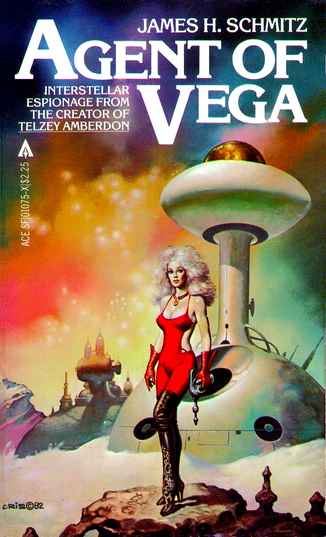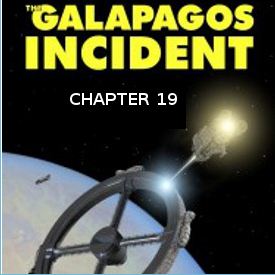No one loves space opera more than I do.
That’s a bold statement and it is likely pretty easy to disprove. Lots of people love space opera, many love it much more than I do.
Nevertheless, I love space opera and one of my favorite writers in that genre is James H. Schmitz.
 James Henry Schmitz was an American science fiction writer born in Hamburg, Germany of American parents. He is best known as a writer of “space opera”, and for his strong female characters (such as Telzey Amberdon and Trigger Argee) who didn’t conform to the “damsel in distress” stereotype typical of science fiction of the time. His best known work is probably his novel The Witches of Karres, but he made a splash in the science fiction world back in 1949 with his longish short story Agent of Vega
James Henry Schmitz was an American science fiction writer born in Hamburg, Germany of American parents. He is best known as a writer of “space opera”, and for his strong female characters (such as Telzey Amberdon and Trigger Argee) who didn’t conform to the “damsel in distress” stereotype typical of science fiction of the time. His best known work is probably his novel The Witches of Karres, but he made a splash in the science fiction world back in 1949 with his longish short story Agent of Vega
Schmitz was ahead of his time in regards to depicting typical gender roles. According to John Clute in the The Encyclopedia of Science Fiction: “From 1949, when “Agent of Vega” appeared in Astounding Science Fiction as the first of 4 stories later assembled as Agent of Vega (collection of linked stories 1960), he regularly produced the kind of tale for which he remains most warmly remembered: Space Opera adventures, several featuring female Heroes depicted with minimum recourse to their “femininity” – they perform their active tasks, and save the Universe when necessary, in a manner almost completely free of sexual role-playing clichés. Most of his best work shares a roughly characterized common background, a Galaxy inhabited by humans and aliens with room for all and numerous opportunities for discoveries and reversals that carefully fall short of threatening the stability of that background.”
 That collection of four stories, titled Agent of Vega, has had a number of editionss and each has had very different cover art, most of which utterly fail to capture what is really great about Schmitz’s story.
That collection of four stories, titled Agent of Vega, has had a number of editionss and each has had very different cover art, most of which utterly fail to capture what is really great about Schmitz’s story.
The first edition was released by Gnome Press in hardcover in 1960. The cover was printed in two tones, red and blue, and the art is somwhat… undefined. There is a vague sort of image suggestive of the inner workings of a spaceship done in blue covered over by a red square that depicts… stars? Maybe?
Not really exciting. It is a poor cover that pales in comparison to other covers put out by Gnome Press.
 The next edition fares a bit better. It was a mass market paperback released by Pocket Books and it features artwork by John Woolhiser. It depicts the male Agent of Vega, Illif, holding a weapon and standing in front of a futuristic city. He stands between a pair of arches which is formed by the letter “A” at the end of Vega. The typography is bold and stark against the mostly white background and it forms just as much a part of the cover art as the images do. More, in fact. The sans serif type pretty much dominates the artwork which is kind of pushed off to the bottom right. Only a single small spaceship and the figure’s bubble helmet indicate that this is science fiction at all.
The next edition fares a bit better. It was a mass market paperback released by Pocket Books and it features artwork by John Woolhiser. It depicts the male Agent of Vega, Illif, holding a weapon and standing in front of a futuristic city. He stands between a pair of arches which is formed by the letter “A” at the end of Vega. The typography is bold and stark against the mostly white background and it forms just as much a part of the cover art as the images do. More, in fact. The sans serif type pretty much dominates the artwork which is kind of pushed off to the bottom right. Only a single small spaceship and the figure’s bubble helmet indicate that this is science fiction at all.
Another paperback edition followed from Mayflower (Dell) in 1964. Again it contains an experiment in typography, the title appearing at an angle against a black background which almost dominates the artwork which is confined to a rounded box on the bottom half. The artwork depicts an asteroid or a small moon against the blue of space surrounded by vague shapes that may or may not represent the passage of spaceships. There is also a strange red shape which represents… who knows? Not exactly an image to conjure with.
1973 saw an edition from Tempo Books, a division of Grosset and Dunlop. This one has a fully painted cover depictiong Pagadan (presumably) the alien female agent. The cover artist is uncredited which is just as well, because the art seems tired and flat. The character is represented by a woman in a desultory pose wearing a silver swimsuit and boots standing against an alien backdrop. The figure looks, for all the world like an escapee from an episode of Star Trek.
Ace Books gave it a try and they tapped rising star artist Boris Vajjejo to produce a cover. Boris manages to produce a completely underwhelming image. It is much the same composition as the previous edition except that the female figure looks like she might have walked off the set of Barbarella rather than Star Trek. This was certainly not Boris’s nor Schmitz’s finest hour.
The most recent paperback edition from Baen Books in 2001 tries the hardest to get it right. Bob Eggleton does a smash up job with his cover art. Pagadan, depicted closest as she is described in the story, is featured prominently against a background of blasting spaceships, planets and space. The antagonist is featured in the background as well, looking more constipated than villainous. Nevertheless, it comes closest to capturing the feel of Schmitz’s story than the others.
Schmitz’s fiction has so much in it and yet he has received very short shrift when it comes to illustrations. Perhaps a future edition will capture his work better. A film or tv adaptation would probably help. There are so many possibilities that are, as yet, sadly unrealized.
(Editor’s note. The Editor loves space opera at least as much as the author.)















…and I love it probably as much as you and Steve Davidson. This is a nicely-done article; I hadn’t seen the Vallejo cover before, and for a moment I thought the Eggleton cover was a Jim Burns, then noticed the background was a lot looser than Jim’s work. A good cover all around, however.
Schmitz was also famous for Witches of Karres and a lot of fun Amberdon stories; his alien ecologies were well thought out, in my opinion. Thanks for the article!